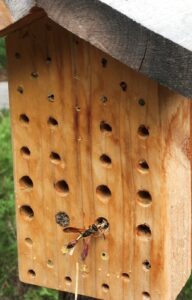
Bee hotels are a popular addition to your backyard or landscape! In Colorado, we have over 900 bee species! Approximately 30% of those bees build nests in cavities, or pre-existing tunnels including bee hotels. Leafcutter bees and mason bees are among the most common bees seen nesting in bee hotels. Cavity-nesting bees may also nest in between patio stones or other landscape infrastructure if it is the right size in diameter.
It is important to make sure these habitats are built and maintained correctly, or else they can negatively impact bee health.
For best practices in building and maintaining a bee hotel, check out the following fact sheets:
- Building and Managing Bee Hotels for Wild Bees by Michigan State University Extension
- Creating a Bee Hotel by Nebraska Extension
Some key points to keep in mind include:
Location
- Protected from rain and moisture, wind, and insect predators
- 4-5 feet off the ground and attach to post, building, or isolated tree
- Face south/southeast so it has light in the morning
- Close to flowering plants
Construction
- Stem bundles: different nesting materials and tunnel diameters will bring variety of bees
- Range from 1/16 to ½ inch in diameter
- Wood block: drill holes 3/32 to 3/8 inches in diameter
- Separate by ¾ inches
- Stem length/hole depth should range from 5-8 inches
- Length increases with diameter
- Possible hotel frame materials: Wooden frame, aluminum can, milk carton, cinder block, plastic bucket, cut PVC pipe
- Make sure you are using untreated wood
- Provide overhang to protect nest from rain
Maintenance
- Must be clean so that they don’t harbor pests and diseases!
- Clean tubes out each year
- Recommend having two sets, one in hotel and one clean and waiting
- Or, replace materials each year!
- Monitor for moisture, ant infestations, paper wasp nest, predatory birds, and spider webs during the season
- At end of season (late fall before first freeze) can move nest to new location (still outside/in the cold) where it is protected from weather, moisture, and birds
- Monitor for when bees begin to emerge
- Place old hotel where bees are emerging from near new hotel, so that bees leave the old nest but come back to new one
What if I find a wasp nesting in my bee hotel?
Adding a bee hotel to your landscape provides you the opportunity with see some of the biodiversity of species that lives in our garden landscapes. In addition to bees, you may notice some solitary hunting wasps nest in the bee hotel. The wasps that nest in your bee hotel are NOT nuisance wasps like the western yellowjacket and the European paper wasps. Solitary hunting wasps do not bother people. They are not attracted to human food sources or human activity. We have a wide variety of species of solitary hunting wasps, and most of the time they go unnoticed. Solitary hunting wasps provide valuable pest control services. Depending on the species, they will hunt pest caterpillars, crickets, and spiders. These wasps post no harm to the bees nesting in your hotel. They are simply looking for a protected place to nest for their offspring. Since solitary hunting wasps keep to themselves, the risk of getting stung is very low.
Do I need to worry about getting stung by bees in the hotel?
The risk of getting stung from a bee at a bee hotel is extremely low. Over 90% of all insect stings are caused by the western yellowjacket, which will not nest in your bee hotel. Yellowjackets are scavenger wasps that can be aggressive, especially when their underground colony is threatened. Other insect stings are usually from the European paper wasp or honey bees, both which could sting to protect their colony. Solitary bees such as the bees that nest in hotels are highly unlikely to sting since they do not have a colony to protect. The male bees cannot sting. The females can sting, but you would need to handle the bee, or have the bee pressed up against your skin to get stung. Bee hotels are often a great way to enjoy bee in your landscape without the worry of getting stung.
The bee hotel I purchased has narrow slots in the wood for butterfly use. Will butterflies use a bee hotel?
Sometimes insect hotels for purchase have narrow, vertical slots that are marketed as butterfly boxes or butterfly hibernation boxes. There is no research or evidence to support that butterflies will use these boxes. One study found that these slots are most likely to be used by the European paper wasp, a nuisance and invasive wasp species (Baker and Potter, 2020). European paper wasps feed on a variety of caterpillars including butterfly caterpillars. To avoid potential wasp nests in your vertical slots of your hotel, consider sealing up the slots. To learn more about attracting butterflies to your landscape, click here.
References
Baker, A.M., & Potter, D.A. (2020). Invasive paper wasp turns urban pollinator gardens into ecological traps for monarch butterfly larvae. Sci Rep 10, 9553. https://doi.org/10.1038/s41598-020-66621-6
Bauer, E. C., Lynch, L. I., Golick, D. A., Weissling, T. J. (2021). Creating a Solitary Bee Hotel. Nebraska Extension. https://extensionpublications.unl.edu/assets/pdf/g2256.pdf
Brokaw, J., Isaacs, R. (2017). Building and Managing Bee Hotels for Wild Bees. Michigan State University Extension. https://pollinators.msu.edu/publications/building-and-managing-bee-hotels-for-wild-bees/’




